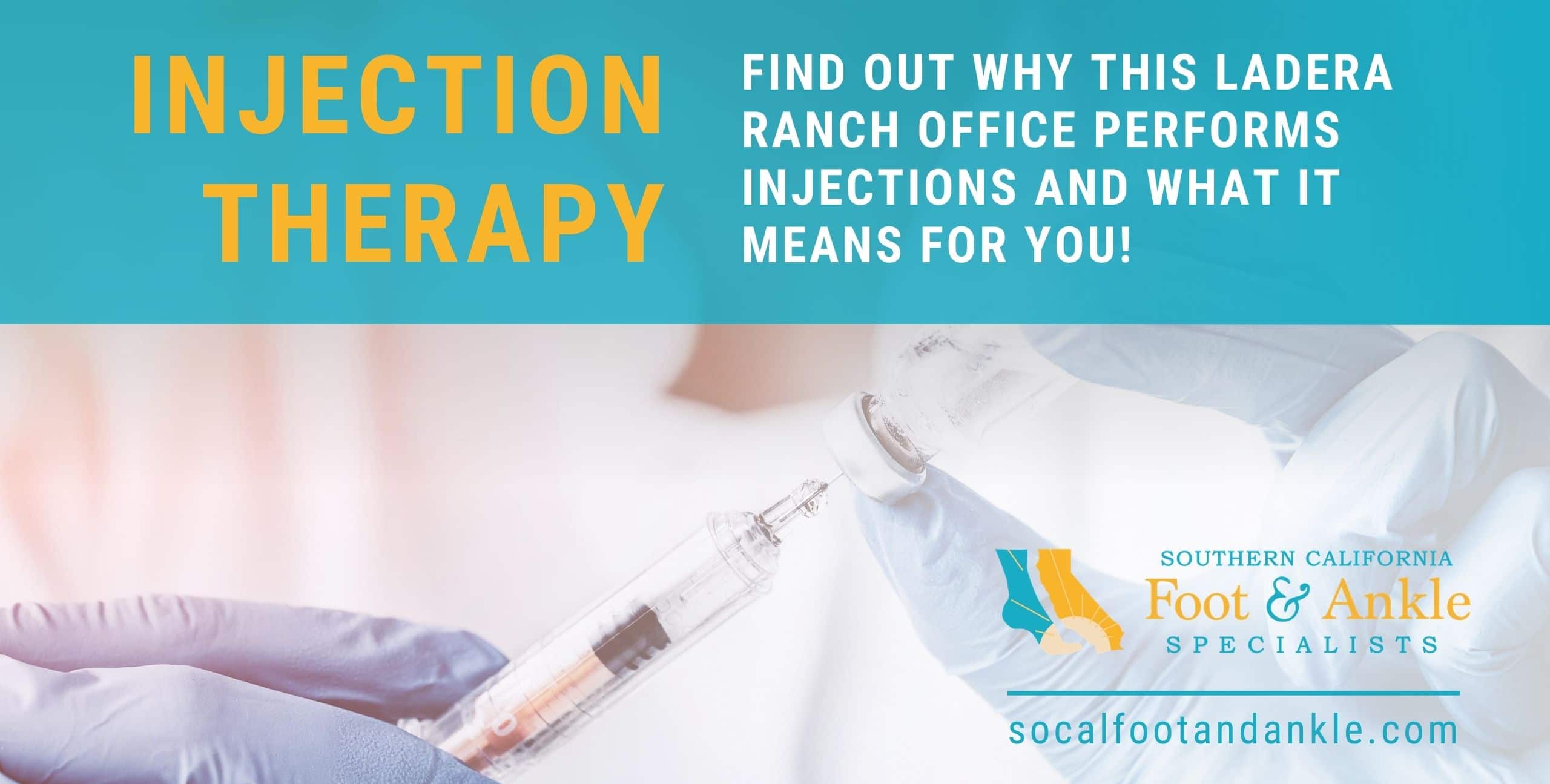Injection Therapy
Every patient who comes to see us here are our Ladera Ranch office is a unique case.
Any situation is going to vary based on factors like severity, age, health, and lifestyle choices. And, of course, there are numerous foot and ankle conditions and injuries that need professional treatment.
Because there are so many variables in play, our team at Southern California Foot & Ankle Specialists provides a wide range of treatment options—and takes the time to create a customized plan for you.
Depending on your case, we may recommend some form of injection therapy to help you overcome the problem. Our hope is always to avoid surgery through less invasive methods, and this option is one that allows us to achieve that for many of our patients.
Again, your unique set of circumstances will determine if this is the right path forward. If it is, you may find improved mobility—and less pain—so you can return to your favorite activities.
Why We Use Injections
Before going further, it’s important to note that we don’t use so-called “pain relief” injections at our Ladera Ranch podiatrist office. Instead, we use safe medications—such as cortisone and other steroids—for the primary purpose of relieving inflammation. Now, reduced inflammation will typically also result in pain relief—and it’s very rare for patients to complain about that! Reducing inflammation is an especially important component in treating conditions like plantar fasciitis, osteoarthritis, and neuromas (painful, swollen nerve tissues). Usually, we administer these injections in soft tissues and joints, and we might include a local anesthetic along with the corticosteroid we’re using. This is all a very safe and simple procedure that we perform in our office. One consideration worth noting for this form of therapy is that the number of corticosteroid injections a patient can receive in a year is often limited. Naturally, this is something we will discuss with you if it is part of your customized treatment plan.Post-Injection Instructions and Notes
You likely are aware that an essential part of optimal healing following surgical intervention is adhering to your doctor’s postoperative instructions. Well, this is similar to the case with injection therapy. Fortunately, most post-injection instructions aren’t terribly difficult to follow. To help you understand what may be entailed with your experience after an injection, we’ve compiled the following list of typical expectations:- You may feel a certain degree of numbness, weakness, or tenderness in the affected foot or ankle. It’s worth keeping in mind that this is completely normal and caused by the anesthetic. These kinds of sensations usually improve within a few hours following the injection.
- There may be some localized tenderness at the site of your injection. Again, this is something that is rather normal. You can usually relieve any minor discomfort by resting and applying ice to the area for 20 minutes at a time (3-4 times per day). OTC pain relievers like Tylenol (Acetaminophen), Ibuprofen (Advil) or Naprosyn (Aleve) are also beneficial.
- You can expect redness and/or localized swelling at the injection site. Those are normal, but if you are experiencing areas that are raised or significantly tender—or the redness is extreme—contact our office as soon as possible.
- It might take several days before you feel the full effects of your injection. This is a fairly typical timeframe for certain cases. Sometimes, the injected medication may actually increase pain for one or two days before improving your symptoms. (If the pain is severe, however, give us a call.)
- Some patients have adverse reactions—which are only temporary—in response to a steroid. When this happens, it will normally include redness or flushing in the face and/or some insomnia. These symptoms will generally only last a couple of days and can be addressed with Benadryl.
- Due to potential infection risk, you will have some water restrictions. More specifically, you simply need to avoid submerging the injection site in standing water—such as in hot tubs, bathtubs, and swimming pools—for 24 hours.
- In the event you have diabetes, you should know that an injection might cause your blood sugar levels to elevate. This is not always the case, so it is especially important that you remain vigilant in checking your blood sugar for the first 2-3 days following an injection. (Although, you should always be vigilant in checking blood sugar levels if you’re diabetic.) Depending on what you find, make appropriate adjustments and notify your doctor who is helping you manage the disease.
- Fevers, chills
- A severe increase in pain
- An allergic reaction
- Something “just doesn’t feel right”
Comprehensive Foot and Ankle Treatment in Ladera Ranch, CA
Our practice’s goal is to help you overcome foot and ankle problems that cause pain and take away your ability to perform favorite activities. Even better is when we can do so without needing to use surgical intervention. Injection therapy is one method we use that can lower your risk of foot or ankle surgery—and it’s an option we’re proud to offer here at Southern California Foot & Ankle Specialists. For more information on this treatment, common foot and ankle injuries, or anything about our practice, please don’t’ hesitate to reach out. You can call us at 949-364-9255 (WALK) or take advantage of our online form to contact us today!Contact Us
Ladera Ranch
333 Corporate Dr. Ste 230, Ladera Ranch, CA 92694
Tel: (949) 364-9255 (WALK)
Fax: (949) 364-9250
Office Hours:
Monday - Friday: 9am - 5pm
*(Lunch 12 noon - 1pm)
Orange
2617 E Chapman Ave. Ste 303, Orange, CA 92869
Tel: (714) 639-7993
Fax: (714) 639-0729
Office Hours:
Monday - Friday: 9am - 5pm
*(Lunch 12 noon - 1pm)

